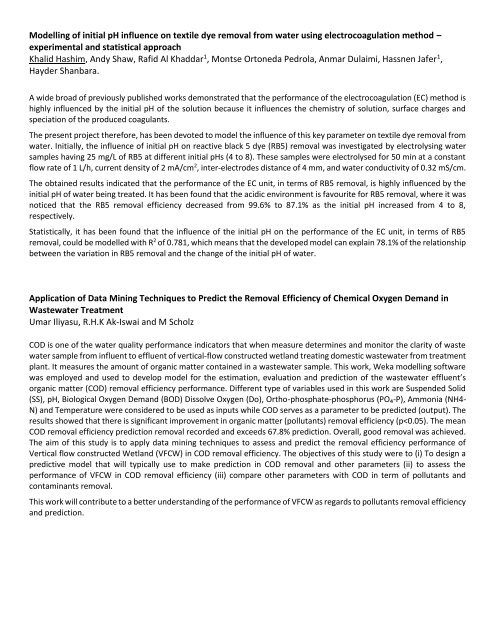Conference Programme FULL (1)
You also want an ePaper? Increase the reach of your titles
YUMPU automatically turns print PDFs into web optimized ePapers that Google loves.
Modelling of initial pH influence on textile dye removal from water using electrocoagulation method –<br />
experimental and statistical approach<br />
Khalid Hashim, Andy Shaw, Rafid Al Khaddar 1 , Montse Ortoneda Pedrola, Anmar Dulaimi, Hassnen Jafer 1 ,<br />
Hayder Shanbara.<br />
A wide broad of previously published works demonstrated that the performance of the electrocoagulation (EC) method is<br />
highly influenced by the initial pH of the solution because it influences the chemistry of solution, surface charges and<br />
speciation of the produced coagulants.<br />
The present project therefore, has been devoted to model the influence of this key parameter on textile dye removal from<br />
water. Initially, the influence of initial pH on reactive black 5 dye (RB5) removal was investigated by electrolysing water<br />
samples having 25 mg/L of RB5 at different initial pHs (4 to 8). These samples were electrolysed for 50 min at a constant<br />
flow rate of 1 L/h, current density of 2 mA/cm 2 , inter-electrodes distance of 4 mm, and water conductivity of 0.32 mS/cm.<br />
The obtained results indicated that the performance of the EC unit, in terms of RB5 removal, is highly influenced by the<br />
initial pH of water being treated. It has been found that the acidic environment is favourite for RB5 removal, where it was<br />
noticed that the RB5 removal efficiency decreased from 99.6% to 87.1% as the initial pH increased from 4 to 8,<br />
respectively.<br />
Statistically, it has been found that the influence of the initial pH on the performance of the EC unit, in terms of RB5<br />
removal, could be modelled with R 2 of 0.781, which means that the developed model can explain 78.1% of the relationship<br />
between the variation in RB5 removal and the change of the initial pH of water.<br />
Application of Data Mining Techniques to Predict the Removal Efficiency of Chemical Oxygen Demand in<br />
Wastewater Treatment<br />
Umar Iliyasu, R.H.K Ak-Iswai and M Scholz<br />
COD is one of the water quality performance indicators that when measure determines and monitor the clarity of waste<br />
water sample from influent to effluent of vertical-flow constructed wetland treating domestic wastewater from treatment<br />
plant. It measures the amount of organic matter contained in a wastewater sample. This work, Weka modelling software<br />
was employed and used to develop model for the estimation, evaluation and prediction of the wastewater effluent’s<br />
organic matter (COD) removal efficiency performance. Different type of variables used in this work are Suspended Solid<br />
(SS), pH, Biological Oxygen Demand (BOD) Dissolve Oxygen (Do), Ortho-phosphate-phosphorus (PO₄-P), Ammonia (NH4-<br />
N) and Temperature were considered to be used as inputs while COD serves as a parameter to be predicted (output). The<br />
results showed that there is significant improvement in organic matter (pollutants) removal efficiency (p


